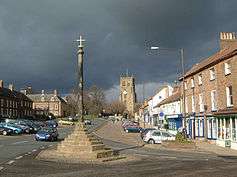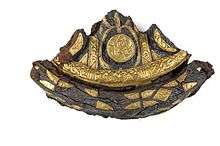Bedale
| Bedale | |
 The centre of Bedale with St Gregory's Church in the background |
|
 Bedale |
|
| Population | 3,156 (Including Firby. 2011)[1] |
|---|---|
| OS grid reference | SE266883 |
| – London | 206 mi (332 km) south |
| District | Hambleton |
| Shire county | North Yorkshire |
| Region | Yorkshire and the Humber |
| Country | England |
| Sovereign state | United Kingdom |
| Post town | BEDALE |
| Postcode district | DL8 |
| Dialling code | 01677 |
| Police | North Yorkshire |
| Fire | North Yorkshire |
| Ambulance | Yorkshire |
| EU Parliament | Yorkshire and the Humber |
| UK Parliament | Richmond |
Coordinates: 54°17′17″N 1°35′28″W / 54.288°N 1.591°W
Bedale is a market town and civil parish in the district of Hambleton, North Yorkshire, England. Historically part of the North Riding of Yorkshire, it is situated 34 miles (55 km) north of Leeds, 26 miles (42 km) south-west of Middlesbrough and 7 miles (11 km) south-west of the county town of Northallerton. It was originally in Richmondshire and listed in the Domesday Book as part of Catterick wapentake, which was also known as Hangshire (so named from Hang Bank in Finghall and because of the many gallows used to execute marauding Scots); it was split again and Bedale remained in East Hang. Bedale Beck is a tributary of the River Swale, which forms one of the Yorkshire Dales, with its predominance of agriculture and its related small traditional trades, although tourism is increasingly important.
History

Before the Harrying of the North Bedale was held by Torpin (Thorfinn), a patronym retained by the infamous Dick Turpin. The parish church also dates from this time (as evidenced by its crypt), before significant remodelling. The recent discovery of the Bedale Hoard provides further evidence of high-status Anglo-Saxon and Viking age activity in the area.[2]
Under the Bretons of Richmond
After being doled out by Count Alan Le Roux to his relative Bodin of Middleham for a short time, the new market town was founded by Scollandus (Henry III later confirmed this charter), a Breton officer in an hereditary position at Richmond Castle. Bedale Hall marks the site of a castle built in the reign of King Edward I of England by Sir Bryan FitzAlan, Lord of the Manor of Bedale and later Baron FitzAlan. After contributing to the defeat of Llywelyn ap Gruffudd, FitzAlan succeeded the Earl of Surrey as Guardian and Keeper of Scotland for Edward I and fought at the Battle of Falkirk (1298) and the siege of Caerlaverock in July 1300. Fitz Alan was involved in a fight with William Wallace that led to the death of a comrade-in-arms[3] and held the castles of Dundee and Forfar, as well as those in the Scottish Lowlands: Roxburgh Castle and Jedburgh. This baron also built Killerby Castle and Askham Bryan in Yorkshire.
Stapleton, Lovell and others
His co-heir jure uxoris, Sir Gilbert de Stapleton of Carleton, Knt, was a conspirator in the assassination of Piers Gaveston. Sir Miles Stapleton was a founding Knight of the Order of the Garter, who fought at the Siege of Calais and at the Battle of Crécy. The Stapletons were "Lollard knights" and were Lords of the Manor of Bedale for generations. Bedale had traditionally been a Lancastrian area, until the Kingmaker, Clarence and Gloucester obtained Richmond and Middleham Castles. Following the Battle of Bosworth Field, Francis Lovell, 1st Viscount Lovell led the charge of insurgency in the Yorkist Stafford and Lovell Rebellion against Henry VII of England, attainted Earl of Richmond. The inhabitants of the region went on several recusancy strikes, such as the Pilgrimage of Grace and made trouble for John Nevill, 3rd Baron Latymer (Catherine Parr's husband before Henry VIII) in Snape Castle. This continued in the Rising of the North, with Henry VII's follower Simon Digby of Aiskew executed and replaced by Ambrose Dudley, 3rd Earl of Warwick, whose wife sold it to the native Sir William Theakston & John Jackson, after which it was resold to Cavalier Henry Peirse, whose descendents are remain in town. During the English Civil War, Philip Stapleton continued in much of the same anti-Tudor & Stuart sentiment as Guy Fawkes, whose statement, when asked by one of the Scottish lords what he had intended to do with so much gunpowder, Fawkes answered him, "To blow you Scotch beggars back to your own native mountains!" Middleham Castle was subsequently demolished by Parliamentarians and Bedale no longer had a fortress in which to resist outside manipulation.
Lords of the Manor
- Sir Alan FitzBrian, Knt., Lord of the Manor of Bedale, &c., (died shortly before 17 May 1267, killed in self-defence by Payn le Keu of Brandesburton), was a descendant of Conan I of Rennes, Duke of Brittany.[4][5] He had two known sons, the younger being Theobald FitzAlan of Stow and Quy (d. 21 February 1308), and was succeeded at Bedale by the eldest:
- Sir Brian FitzAlan Knt., (d. 1 June 1306), J.P., High Sheriff of Yorkshire, &c.[6] He was summoned to parliament from 24 June 1295 to 22 January 1305 by Writs directed to Briano filio Alani whereby he is held to have become Lord FitzAlan. Upon his death any hereditary peerage created by the Writ of 1295 is held to be in abeyance.[7]
His daughters Agnes (born 1298) and Katherine (born 1300) were his co-heirs in his landed estates and manors. They were also co-heirs to his brother, Theobald.[8] Katherine (d. before 7 August 1328) married Sir John de Grey, 1st Baron Grey de Rotherfield, KG (9 October 1300 – 1 September 1359).
The estate of Bedale and the Lordship of the Manor passed via the eldest daughter: Agnes FitzAlan, whose marriage was granted on 10 May 1306 (when she was aged just 8) to Sir Miles de Stapleton of Carlton, Yorkshire for his son:
- Sir Gilbert de Stapleton, Knt., (d. before 23 June 1324) a younger son, whom she married before 15 December 1317,[9] in whose family Bedale remained for over a century, and was still in the possession of their great-great-grandson,
- Sir Miles Stapleton who died 30 September 1466.[10] His younger brother Brian Stapleton of Crispings (in Happisburgh) and Hasilden, Norfolk died about the same time and they both left only co-heiresses.[11]
The Lordship of Bedale Manor is currently held jointly by Lord Beaumont, heir of both FitzAlan moiety lines, but the Beresford-Peirse baronets retain distinction as having de facto possession of the manor, which was originally forfeited by Lovell's attainder and passed on to numerous installments of government figures and subsequent real estate purchasers, whether Digby of Warwickshire, Dudley of Nottinghamshire, native Theakston and Jackson, then Peirse, after which it passed by inheritance to Beresford of Derbyshire.
Governance
An electoral ward in the same name exists. This ward includes Aiskew parish and had a total population of 4,601 at the 2011 Census.[12]
Churches
- St Gregory's
This Gothic church retains some Catholic relics, although during the English Civil War Puritans vandalised features such as statues. St Gregory's has a painting of St George slaying the dragon, unusual in that St George is depicted as being left-handed, and also contains a stone Viking age grave marker, notable for a rare depiction of the legend of Wayland Smith. When Scots raided the countryside, inhabitants expected to find security in St Gregory's pele tower. Bedale St Gregory is the parish church in the Church of England in the rural deanery of Wensley within the Diocese of Leeds. The current incumbent is the Reverend Ian Robinson, who joined the benefice in 2012, and its patron is the present Beresford-Peirse baronet. There is a plaque in the church listing all priests of the parish. There is another plaque of the previous landlords of Bedale, featuring coats of arms of these people or their families: Fitzalan, Stapleton, Grey of Rotherfield (related to Lady Jane Grey), Sheffield, de Warrene (Earl of Surrey), Brian de Thornhill, Lawrence de Thornhill, Richard, 1st Earl of Cornwall, Henry, 3rd Earl of Lancaster, Fitz Hugh of Tanfield, John of Brittany, Earl of Richmond, Marmion, Arthur III, Duke of Brittany and Ascough/Aiskew.
St Gregory's had a daughter church known as St Augustine's Church and Village Hall at Leeming Bar although this is no longer used for worship, and a Mission Chapel at Burrill. There are other local Anglican chapels, such as St Gregory's at Crakehall and St Patrick's at Patrick Brompton. Two other parishes with churches joined in the benefice with St Gregory's are St John the Baptist (Leeming village) and St Mary the Virgin (Thornton Watlass).
- St Mary's & St Joseph's
In Aiskew, founded in the 19th century by the Stapletons, who remained the local Catholic landlords after the Reformation. The Tudors had made sure to seize the original parish church of St Gregory and align it with their policies enacted by the Earl of Warwick's faction (which was not local), which supplanted the earlier Tudor implant of the Digby family, who had "gone native" and been drawn into local sympathies of anti-Elizabethan rebellion.
- Others
There are Methodist chapels in Bedale, Leeming, Crakehall and Aiskew. Some buildings in the area also have their own private chapels, such as at Christ's Hospital in Firby.
Economy and attractions
Existing historic buildings include a unique 18th-century Leech House used as an apothecary's store for leeches, an underground ice house used for preserving food and the 14th-century market cross. Bedale is home to a small museum, numerous Georgian buildings and a railway station on the Wensleydale Railway, which runs to Redmire via Leyburn. The Thorp Perrow Arboretum lies nearby, as do the villages of Burneston, Burrill, Cowling, Exelby and Firby.
The town has many local shops, pubs and eating places along its market place. It holds a market every Tuesday on the cobbles that line the market place. It also has a leisure centre with full gym, swimming pool and astroturf sports pitches. Bedale Athletic Sports Association provides football, cricket, hockey, squash and tennis. Big Sheep Little Cow Farm is a petting zoo and the Wensleydale Railway is the local line.
Bedale Golf Club is 800 yards north west of the town on the A684 road to Leyburn.
References
- ↑ "civil parish population 2011". Neighbourhood Statistics. Office for National Statistics. Retrieved 28 July 2015.
- ↑ "Beauty of hoard is revealed as rare Viking treasures displayed". Yorkshire Post. 12 December 2014. Retrieved 15 December 2014.
- ↑ "Sir William Wallace (1267 - 1305)"; Lenymede.demon.co.uk
- ↑ Cokayne, G. E., edited by the Hon. Vicary Gibbs & H. A. Doubleday, The Complete Peerage, London, 1926, vol.5, p. 393.
- ↑ Burke, John, History of The Commoners of Great Britain and Ireland, London, 1835, vol. II, p. 583n, says "descended from Alan, Duke of Richmond and Brittany".
- ↑ Dictionary of National Biography, Oxford, 1904.
- ↑ Cokayne (1926) vol.5, p. 398
- ↑ Cokayne (1926) vol. 5, p. 395
- ↑ Burke's Commoners (1835) p. 208
- ↑ Cokayne (1926) vol. 5, p. 397
- ↑ Richardson, Douglas, Plantagenet Ancestry, Baltimore, Md., 2004, pp. 57/8 and 608.
- ↑ "Key Figures for 2011 Census: Key Statistics - Area: Bedale (Ward)". Neighbourhood Statistics. Office for National Statistics. Retrieved 24 September 2016.
External links
| Wikimedia Commons has media related to Bedale. |
- "Bedale North Yorkshire"; Bedale.org.uk
- "Benefice of Bedale";
- "Explore Bedale"
- "Lords, and lady, to the manor born"; The Northern Echo, 6 July 2001. Retrieved 19 June 2012
- "View of the Extinct Peerage of England"; Genuki
- "Church of St Gregory's Bedale"; Brigantesnation.com
- "Bedale's Unique Medicinal Leech House"